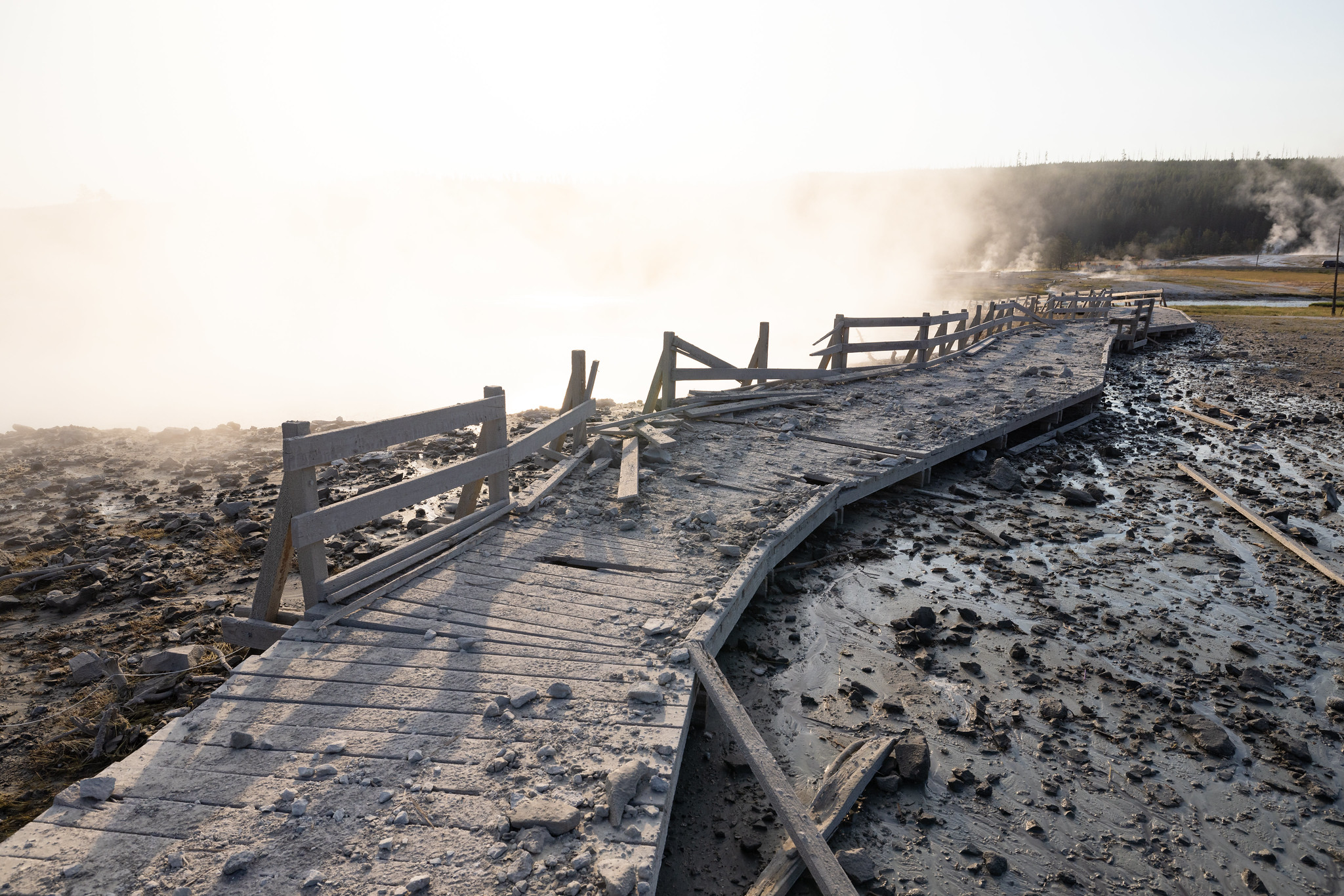News Release

NPS / Jacob W. Frank
|
Subscribe
|
Contact: Morgan Warthin (Yellowstone National Park), 307-344-2015
Contact: Mike Poland (USGS)
Update on the July 23 Biscuit Basin hydrothermal explosion
Date of release: July 24, 2024
USGS Volcano Notice - DOI-USGS-YVO-2024-07-24T21:27:48+00:00
YELLOWSTONE (VNUM #325010)
44°25'48" N 110°40'12" W, Summit Elevation 9203 ft (2805 m)
Current Volcano Alert Level: NORMAL
Current Aviation Color Code: GREEN
This is an update on the hydrothermal explosion that occurred just before 10 AM on Tuesday, July 23, in Biscuit Basin, Yellowstone National Park.
National Park Service (NPS) field crews have completed a preliminary assessment of the conditions following the hydrothermal explosion at Black Diamond Pool. For a map showing the locations of the features in that area, see https://www.usgs.gov/media/images/map-major-features-biscuit-basin-yellowstone-national-park.
What happened?
The July 23, 2024, hydrothermal explosion at Biscuit Basin resulted from water suddenly transitioning to steam in the shallow hydrothermal system beneath Black Diamond Pool and was not caused by volcanic activity. Seismicity, ground deformation, and gas and thermal emissions remain at their normal background levels, and there were no detectable precursors to this event.
The explosion, which sent steam and debris to a height of hundreds of feet above the ground, destroyed a nearby boardwalk and ejected grapefruit-sized rocks tens to hundreds of feet from the source. Some blocks closest to the explosion site are about 3 feet (1 meter) wide and weigh hundreds of pounds. The explosion was largely directed to the northeast toward the Firehole River, and the largest blocks of debris fell in that direction. The dark color of the explosion was a result of mud and debris mixed with steam and boiling water. Although visitors were present at the time of the event, no injuries were reported.
Black Diamond Pool and Black Opal Pool were affected by Tuesday’s explosion, and while they remain distinct features, the shape of Black Diamond has changed somewhat. Both pools are murky due to debris, and the unstable ground around their edges occasionally slides into the water. Just after the eruption, Black Diamond Pool exhibited minor roiling and water spouting. The water level in the pool rose over the course of the day, and by Tuesday afternoon the roiling transitioned to occasional bursts of hot water that reached about 8 feet (2.4 meters) in height.
What is happening now?
By Wednesday morning, July 24, the levels of Black Diamond Pool and Black Opal Pool had risen enough that both were overflowing and sending murky water into the Firehole River. No water bursts from Black Diamond Pool were witnessed Wednesday morning.
What are ongoing hazards?
Given the recent changes to the hydrothermal plumbing system, small explosions of boiling water from this area in Biscuit Basin continue to be possible over the coming days to months. USGS and NPS geologists will be monitoring conditions, mapping the debris field, and sampling water to assess any changes in the shallow hydrothermal system over the next several days.
Hydrothermal explosions typically occur in the park one to a few times per year, but often in the back country where they may not be immediately detected.
Similar, although smaller, hydrothermal explosions took place in 1989 at Porkchop Geyser in Norris Geyser Basin, and on April 15, 2024, from the Porcelain Terrace Area of Norris Geyser Basin. A small hydrothermal explosion occurred from Wall Pool, in Biscuit Basin, in 2009. Significant hydrothermal explosions, probably similar in size to that of July 23, 2024, occurred in the 1880s at Excelsior Geyser, in Midway Geyser Basin.
Yellowstone National Park has closed Biscuit Basin for the remainder of the 2024 season for visitor safety. Grand Loop Road remains open to vehicles, and other nearby thermal basins, like Black Sand Basin, are open. Additional Yellowstone National Park information about visitor access can be found at https://www.nps.gov/yell/index.htm.
More information
Yellowstone Volcano Observatory monitoring website: https://www.usgs.gov/volcanoes/yellowstone
2022-2032 YVO Monitoring Plan: https://pubs.usgs.gov/publication/sir20225032
Preliminary Assessment of Volcanic and Hydrothermal Hazards in Yellowstone National Park and Vicinity: https://pubs.usgs.gov/publication/ofr20071071
Yellowstone National Park images from Biscuit Basin explosion site: https://www.flickr.com/photos/yellowstonenps/albums/72177720319112324/
The Yellowstone Volcano Observatory (YVO) provides long-term monitoring of volcanic and earthquake activity in the Yellowstone National Park region. Yellowstone is the site of the largest and most diverse collection of natural thermal features in the world and the first National Park. YVO is one of the five USGS Volcano Observatories that monitor volcanoes within the United States for science and public safety.
YVO Member agencies: USGS, Yellowstone National Park, University of Utah, University of Wyoming, Montana State University, EarthScope, Wyoming State Geological Survey, Montana Bureau of Mines and Geology, Idaho Geological Survey
Biscuit Basin in Yellowstone National Park temporarily closed due to hydrothermal explosion
Date of release: July 23, 2024
- On Tuesday, July 23, at about 10:19 a.m., a localized hydrothermal explosion occurred near Sapphire Pool in Biscuit Basin, located just north of Old Faithful.
- Biscuit Basin, including the parking lot and boardwalks, are temporarily closed for safety reasons. The Grand Loop Road remains open.
- No injuries were reported and the extent of damage is unknown at this time.
- Park staff and staff from USGS will monitor conditions and reopen the area once deemed safe.
- No other monitoring data show changes in the Yellowstone region. Today’s explosion does not reflect a change in the volcanic system, which remains at normal background levels of activity.
- This is an evolving incident, and additional details will be shared as more facts are known.
- Learn more about geology in Yellowstone.
- View a joint statement between Yellowstone National Park and U.S. Geological Survey about the hydrothermal explosion: USGS Volcano Notice - DOI-USGS-YVO-2024-07-23T19:18:45+00:00
- View photos of the hydrothermal explosion on Yellowstone's Flickr.
Last updated: July 24, 2024
